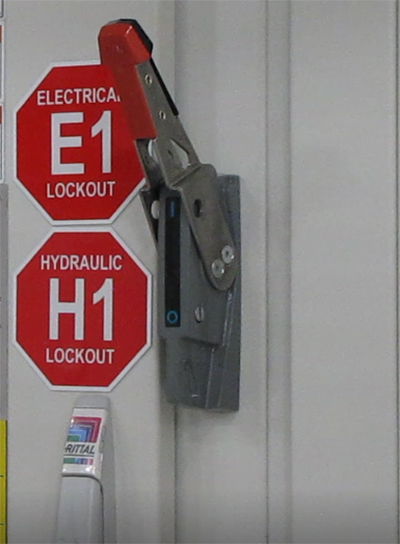Electrical Safety
The following guidelines must be used to promote electrical safety of the operation and maintenance personnel:
- Refer to ECPL signs, for the proper technique of ensuring the complete lockout of power sources.
- Electrical voltage can cause death if not treated with care.
Do not operate the machine if the control cabinet doors, terminal boxes or operator console are open.
- Before starting any maintenance work on the machine or on the control cabinet,
the main switch must be turned off and secured against being turned on providing nothing to the contrary has been specified in the Maintenance Instructions for the individual case.
Components that are still live when the master switch is turned off carry a notice to that effect.
Before switching the machine off at the master switch, carry out the shutdown procedure.
- Only qualified, specialist personnel must establish an electrical connection of the machine to the mains power supply or carry out work on electrical equipment and the control cabinet.
This work must comply with the rules and regulations applicable at the site of installation and should be done only after they have become thoroughly familiar with the equipment.
- It must be assumed at all times that power is "ON" so all conditions must be treated as live.
This practice develops a caution that may prevent an accident.
- Remove power from the affected circuit or equipment.
- Make certain that you have opened the circuit by using the proper test equipment.
- Fault-free operation of the machine is guaranteed only when the control cabinet doors are closed.
The use of mobile and radio telephones, receivers or other high-frequency devices in the direct proximity of an open control cabinet is forbidden.
- The electrical equipment of the machine must be checked at regular intervals. Any defects, such as loose connections or burned cables, must be rectified immediately.
NOTE: Test equipment must be checked at regular intervals.
- Before working on high voltage assemblies, connect the mains cable to earth after isolating the power supply.
- Capacitors must be given time to discharge.
When troubleshooting "LIVE" equipment, take the following precautions:
- Make certain your tools and body are clear of potential grounds.
- Use extra precaution in damp areas.
- Be alert and work without any outside distraction.
- Place the main disconnect in the OFF position and lock it out using approved locks to ensure that no one can remove your personal lock.
- GROUND CONNECTIONS cause fault currents to flow directly into the ground instead of flowing through the body into the ground.
All electrical devices must be properly grounded.
- Shock hazards could exist at the test points or in the test point area and/or transients induced by the probes could cause a machine action.
- Electrical panels must not be opened if the ground light is on by anyone other than a qualified,
authorized electrician for any reason.
- Before any repair work is conducted on electrical circuitry, a voltage check must be made to ensure that dangerous voltages do not remain in the circuitry.
Use a voltmeter or multimeter to check that these components are not live.
- Always use electrically insulated tools and utilize shock avoidance techniques.
- When working with earthed tools, such as soldering irons and electric hand drills, the machine master switch and,
if applicable, any external power circuits must be switched off.
- Only regulation fuses with the physical and electrical characteristics specified are to be used as replacements.
Makeshift or improvised fuses are not to be used under any circumstances.
- Before applying power to any equipment, establish, without any doubt, that all persons are clear.
- The control panel doors must be opened only when it is necessary to check out the electrical equipment or wiring. After closing the door,
make certain that the disconnecting means is operating properly with the main disconnect.
- All covers on junction boxes must be closed before leaving any job.
- Before restarting equipment, read and understand all cautions, warnings and danger notices.
- Do not alter circuits unless authorized to do so by the manufacturer.
- Do not alter or bypass protective interlocks.
- Do not place jumper wires across fuses or trip switches.
- When conductors are replaced they must conform to the manufacturer's specifications,
including proper color-coding.
- Be sure to return the maintenance key, if applicable, to its storage location in Electrical cabinet when not in use.
- If a fault occurs in the power supply system, switch off the machine immediately.
Isolating the machine
Machine and installation components on which maintenance work is to be carried out must - if specified - be isolated from the electrical power supply.
First ensure that the isolated components are voltage free and then earth and short-circuit them and isolate them from adjacent, live modules.
NOTE: The control cabinet is still live when the master switch has been turned off.
Interference voltage circuits
Interference voltage circuits
If interference voltage circuits are present, these must be isolated separately.
NOTE: The control cabinet is still live when the master switch has been turned off.
Circuit boards and connectors
Isolate the machine from the power supply before removing printed circuit boards or connectors.
Protect unused connectors from dirt by using blanking covers and plugs.
